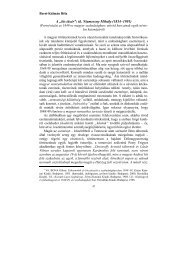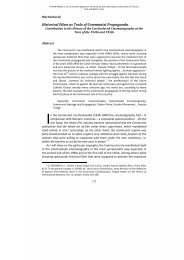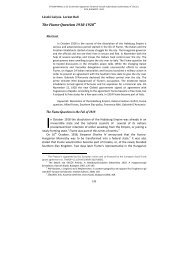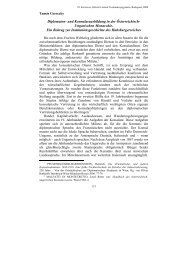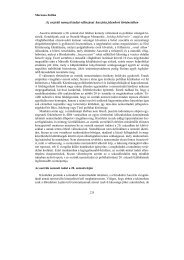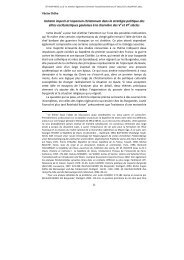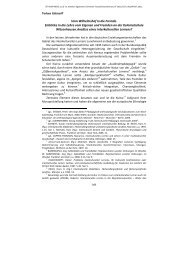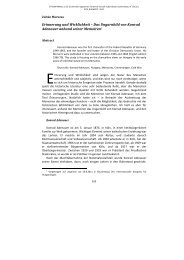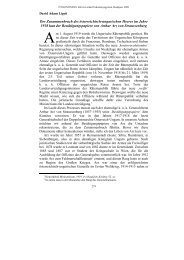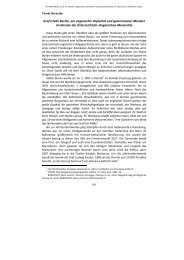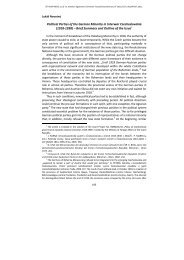The Molotov-Ribbentrop Pact - ELTE BTK Történelem Szakos Portál
The Molotov-Ribbentrop Pact - ELTE BTK Történelem Szakos Portál
The Molotov-Ribbentrop Pact - ELTE BTK Történelem Szakos Portál
You also want an ePaper? Increase the reach of your titles
YUMPU automatically turns print PDFs into web optimized ePapers that Google loves.
the „matter”, where there was a permanent detailed overview of the „emigrant”<br />
figures, on the other hand he praised the total collection of the instances by the<br />
SD. So the hegemonic position of the SD was a very important matter for the SS<br />
leaders. Hagen also noticed in his report that the system is apparently selffinanced,<br />
which of course was only possible by the robbery of the fugitives. He<br />
considered it necessary to expand his authority and he was considering a possible<br />
extension of the „Vienna Approach” throughout the Reich. 46<br />
Eichmann was not the inventor but the driving force behind the<br />
„Zentralstelle”. He took care of efficiency and made a million dollar business.<br />
<strong>The</strong> horror of it was that the robbery was not completed by SS men, but by<br />
helpless employees of the Jewish Community. <strong>The</strong> „Desk Murderer” Adolf<br />
Eichmann made his victims to „helpers”. 47 As if that fact would not be already<br />
sad enough, many of these involuntary „helpers” came after the war under the<br />
suspicion of having collaborated willingly with the Nazis. 48<br />
So shortly after the foundation, the „Zentralstelle” was pointing the way for the<br />
whole Reich. As Safrian writes, Hagen had recognized the trend-setting significance<br />
of the „Vienna model”: 1. Compulsory expulsion of those robbed of their<br />
possessions; 2. Payment fort he management of „emigration” either by the victims<br />
themselves or through foreign currency provided by Jewish organizations abroad; 3.<br />
Extension of the power of the SD by assuming executive privileges 49 .<br />
In the practical implementation of their bureaucratic work, Eichmann and<br />
his men did not forget to give themselves as „Aryan masters” towards their<br />
victims and to harass them. Humiliation and violence were on the agenda. 50<br />
After two months, Eichmann sent the numbers of his previous „work” to<br />
Berlin. He proudly told of the increase in the daily „emigration figure” to 350.<br />
Until the 20 th of September 1939 therefore 38.000 Jews had „left” the country.<br />
Together with the after Nazi views „illegally relocated” Austrian Jews, he<br />
came up with a figure of 50.000 displaced persons. 51 <strong>The</strong>se figures were<br />
inflated. Of the approximately 40.000 „under supervision” expelled Jews could<br />
have been „treated” at most one quarter by the „Zentralstelle”. Eichmann’s<br />
superiors were, however, blinded by these figures and took them seriously. 52<br />
Lozowick’s verdict on the year 1938: „In summary, 1938 displayed two new<br />
trends: the transition to operational activity, and dwindling active<br />
46<br />
SAFRIAN, Hans: Eichmann’s Men. 32-33.<br />
47<br />
KNOPP: Helfer. 35. LEGENSTEIN, Roland: Adolf Eichmann - der Schreibtischtäter.<br />
Koordinator der „Endlösung” Dipl.-Arb., Wien, 2002. 37-38.<br />
48<br />
An interesting as equally sad contribution from the newspaper Profil on the issue No. 28<br />
online at: http://www.vwi.ac.at/ausstellung_jmw/pressespiegel/2007-07-09_Profil_Nr28_IKG-<br />
Archiv-Austellung_JMW_k.pdf (1. 4. 2010).<br />
49<br />
SAFRIAN, Hans: Eichmann’s Men. 33.<br />
50<br />
Ibid. 34.<br />
51<br />
Vgl.: Ibid. 35. BURLEIGH, Michael: Die Zeit des Nationalsozialismus. Frankfurt am<br />
Main, 2000. 372. Profil: Issue No. 18, 28. April 1995. 62.<br />
52<br />
SAFRIAN, Hans: Eichmann’s Men. 35.<br />
85



